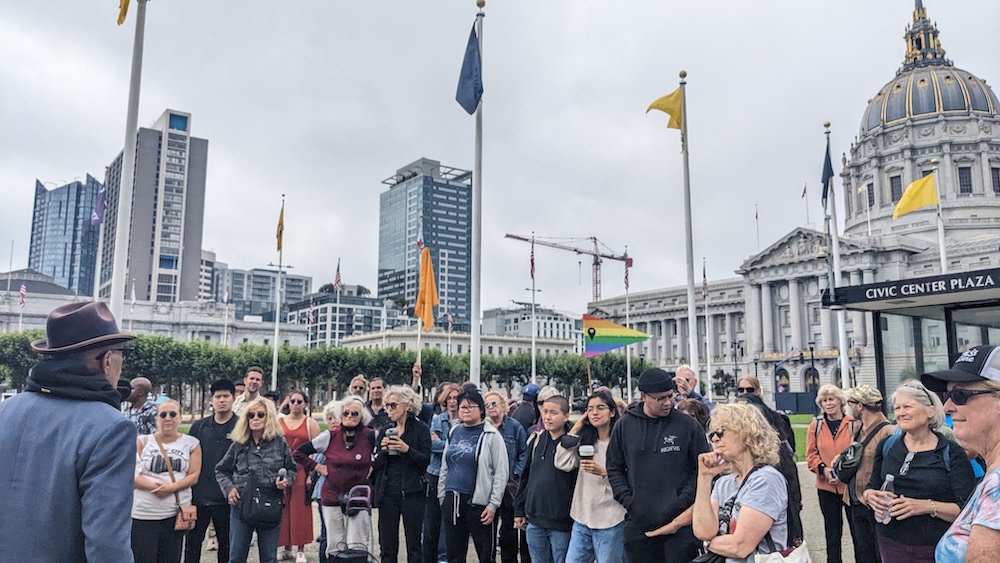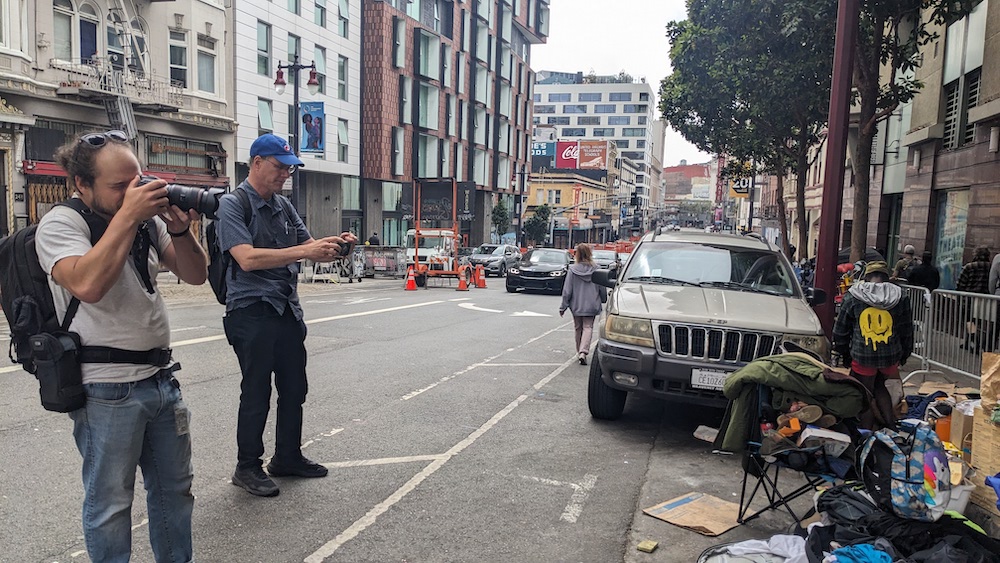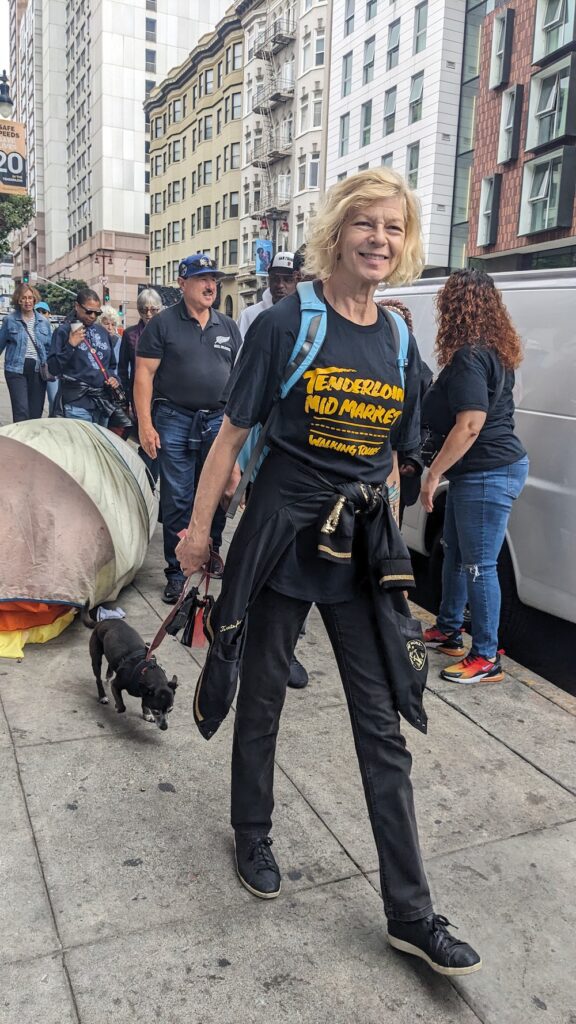Much like the media-hyped “doom loop” itself, a “downtown doom loop tour” billed on EventBrite by an alleged “City Hall insider,” slated for Aug. 26, never took place.
Instead, on a sun-splashed Saturday, nearly 100 San Francisco residents and visitors took Del Seymour’s Tenderloin Walking Tour and got a quite different view of this storied central city neighborhood, its strife and strivings.
The Tenderloin tour disrupted the “doom loop” literally and metaphorically, offering a “positive” lens into the virally-maligned neighborhood, organizers said.

Del Seymour speaks to the crowd at Civic Center plaza. Photos by Christopher D. Cook.
The purported “doom loop tour,” Seymour told us, “was such a mean-spirited effort, I just can’t respond to meanness. The stupidity of it, I just can’t respond to it, so to give people an alternative I designed this tour today.” Purveyors of the “doom loop” narrative, Seymour added, “are using these people, using this community as fodder for their political campaign.”
In fact, Seymour has been leading the tours for 17 years, after living in the Tenderloin for 38 years. “I’m here every day, seven days a week,” he said as we departed gold-gilded City Hall for one of the city’s lowest-income and most diverse neighborhoods.
Asked if the Tenderloin is worse now than in years past, Seymour said that other than the recent fentanyl trend, “we’re the same.” In the mid-1980s, he noted, “we had crack cocaine that was devastating people. This is nothing compared to crack cocaine, and I was part of that.”
On the tour’s first stop, at the northeastern edge of the Civic Center Plaza that spreads like a rectangular fan out from City Hall, Seymour observed, “We are standing on top of our old convention center, before the Moscone Convention Center was built.” He added pointedly, “I don’t know why we’re not using it to facilitate some of our services for unhoused folks, because it’s a 50,000 square foot hall that’s just got some old furniture sitting in it.”
Snaking through the Tenderloin and on to Mid-Market, Seymour’s tour not only offers a rebuttal to the “doom loop” narrative prevailing in mainstream local and national media, but also provides a rare optimistic glimpse of “the beating heart of a city peopled by immigrants and iconoclasts, artists and activists, sinners and saints,” its website describes.

New York Post photographer focuses on ‘doom loop’ images
A few blocks from City Hall, across from the federal court and law enforcement building on Hyde Street, Seymour noted, “we are surrounded by US marshals, they drive through the Tenderloin like nothing’s up.”
At a stop in Glide Memorial Church’s nonprofit services center on Ellis Street, which ladles out 1,500 meals a day to homeless people, Seymour shared a morsel of that lurid, colorful history. A century ago, in ways different and similar to today, “The Tenderloin was a pretty raunchy place,” Seymour related—though, he quickly added, “Other people said it was a pretty fun place.”
When James “Sunny” Rolf became mayor in 1912, “All the vice was in North Beach,” but then Rolf “started buying property in North Beach, so he ran all the vice to the Tenderloin so he could clean up his neighborhood, which is now Telegraph Hill. That’s how the Tenderloin got the vices that it has.” The parallels with today are inescapable, as the Tenderloin remains a containment zone for much of the city’s most intense poverty and at least some of its vices.
Junior Ward, a videographer and social media coordinator for Glide, chimed in, noting, “we not only pass out meals to people, we help people find housing, get education… We specialize in creating a space where everyone feels welcome, appreciated, and loved.”
As the crowd wound its way down Turk, Hyde, and Ellis Streets and on to Jones and then Market Street, there was no shortage of suffering in view—people living in tents, garbage piled high, people hobbled by illness, addiction, poverty, and the visible scars of a rough life on the streets. Yet amid these realities, which are the sole focus of mainstream media coverage and the “doom loop” narrative, the Tenderloin also is home to families, people in recovery, and a panoply of nonprofits providing direct services to people in need.

Lauren Swiger and her dog walk with tour. Swiger lives in a Tenderloin hotel and says she and many others are “thriving” in the Tenderloin. She wants to stay in the neighborhood.
But as Seymour pointed out, the Tenderloin community is far more than the most easily visible misery on some of its sidewalks. At stops along the way, he showed the crowd various affordable and workforce development housing projects, some still partly vacant. He also mentioned the 2000 University of California Law School (formerly known as “Hastings”) students from around the world living in the Tenderloin. “There’s a bunch of groups of people living here that you all don’t even know about.”
I briefly interviewed a photographer for The New York Post—which has run no shortage of its own “doom loop” stories about San Francisco. Asked what drew him to cover the “doom loop tour” that was his original assignment, he replied, “it’s kind of interesting that someone wants to exploit the poverty.”
The Post’s reporter on the scene, Marjorie Hernandez, would not speak with us, but issued an article that, predictably, hyped the area’s blight—featuring the phrase “drug-infested San Francisco” in its opening sentence—while downplaying the tour’s more positive portrayals of the community.
Seymour said he sees the community and its struggles quite differently. When asked what the media are getting wrong about the Tenderloin, Seymour said, “That people want to be out here [in the streets]. That people are refusing services, which they’re not…. The narrative is that we people in the Tenderloin have gotten trenched in, and we like this and we’re comfortable with it, and that’s damn sure not the case. We are not comfortable with this at all. We’re uncomfortable with how they’re treating us.”
Contrary to the viral “doom loop” narratives of crime and death, Seymour added, “People here are friendly, it’s really a mild calm neighborhood, you don’t need a bullet-proof vest to come through here.”
Tenderloin resident Tyree Leslie, who works with Code Tenderloin and is training to help lead the walking tours, told me, “We’re all from the neighborhood, we’ve all been through stuff here. We know the people in the neighborhood, we know the people in the streets, we can talk to them… we’re a community like anywhere else. We accept everyone, we don’t try to push anybody out.”
Leslie was unhoused during the pandemic, then got into a temporary shelter-in-place hotel, and now lives in an apartment on Ellis. “There is a lot of great support, a lot of good people doing good things here. I’m tired of the negative news, I’m tired of people coming zipping through here and not talking to anyone who lives here.” Of the “doom loop tour,” Leslie said, “Whoever that was, for EventBrite to let them do that anonymously, that’s cowardice.”
Lauren Swiger, another Tenderloin resident on the tour, described how she ended up in the neighborhood. “At the end of last year, I lost my home under some really challenging and cruel circumstances, that’s how I find myself here,” where she says she is “thriving” while living in a hotel on Leavenworth and Eddy that serves women who are victims of domestic violence and assault.
She had strong words for the “doom loop tour” and its broader narrative. “To capitalize on people’s suffering is just atrocious, evil and greedy,” Swiger said. “We already have an issue of misrepresentation here in the Tenderloin, overlooking all of the help, all of the programs, all the coalitions, all of the community that is here, which is one of the reasons I don’t want to leave here now. Overlooking all of that and just focusing on the suffering and addiction and poverty is just so awful. That’s why many of us are here today, to highlight the positives.”
What positives, I asked Swiger? “The positive things I see are all of the help, all of the substance abuse treatment programs, all of the supportive housing…. A lot of people are here because they are turning their lives around, getting back on their feet.” She added: “The doom loop is focusing on the people that are down and out but that is negating the many, many more people who are here building their lives up to need that extra help. All that positivity is being ignored by the doom loop. There are many, many more of us here who are turning our lives around and giving back to the community.”
Swiger said the “doom loop” media fixation is misrepresenting the Tenderloin and obscuring the community’s rich culture and care. “There’s a lot of creative performance, art, and music happening here,” said Swiger, who is part of Skywatchers, a multi-disciplinary arts and performance group that works and performs in the community. “One of the things that art does is help you heal, and there’s a lot of that going on, but it doesn’t get any press. Fentanyl gets all the press.”
Anne Bluethenthal, a founder and director of Skywatchers, said she wants people to see “the love of humanity here. … Anything that cuts through the othering that the national media is doing in the Tenderloin.” The media, she said, “has a hunger for poverty porn, objectification, or spectacularization of people’s misery. Instead of focusing on the centuries that made this situation inevitable and the responsibility that we all have to take care of each other.”
Along our way down Jones Street, Seymour pointed out a small business, a Middle Eastern woman running a restaurant. “There were hundreds of people hanging out on the block,” Seymour described. “She would come out there every day and ask people, I’m trying to open a business, could you just move down a little bit? She just did it day by day, took her one year, but she completely cleaned up that corner all by herself. Nobody went to jail. It’s the way you talk to people.”
Toward the end of the tour, as we made our way down Market Street after a visit to the International Art Museum of America, I spoke with Jason and Marie, a married couple living in the Outer Sunset, who have made San Francisco their home for ten years.
Asked what she gleaned from the tour, Marie responded, “the history and all the activism here are really inspiring. All of the nonprofits that are working really hard to transform people’s lives.” The doom loop narrative, she said, “is not helping anyone. It’s not helping our city recover, it’s not helping our small business merchants, it’s not helping our neighborhoods. Something like this countering that, showing pride and love for the city, a willingness to make things better, that’s a positive thing.”
As we neared the end of the walk along Market Street, Marie’s husband Jason added some choice and pointed reflections: “It seems like there is a political faction that needs San Francisco to fail to prove some point about the failures of the left. To me the irony is, San Francisco is the site of people making a ton of money off of capitalism and at the same time having such inequality.” Still, Jason said, “We love it here, we want to stay here, and we want to see this city turned around and be an example for how to have everybody live well and not just those that make a bunch of money off of tech.”
Christopher D. Cook is an award-winning journalist and former city editor of The San Francisco Bay Guardian. He also writes for Harper’s, Mother Jones, The Atlantic, The Los Angeles Times, and others. Contact him through www.christopherdcook.com.




